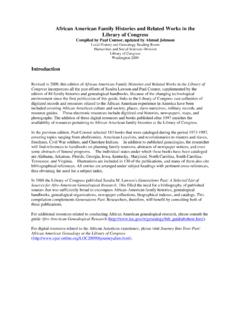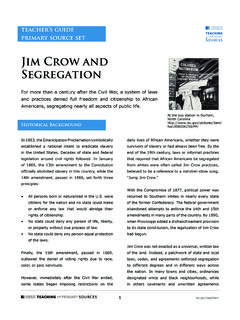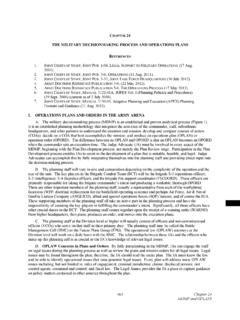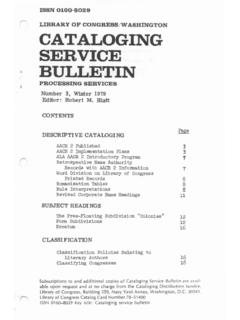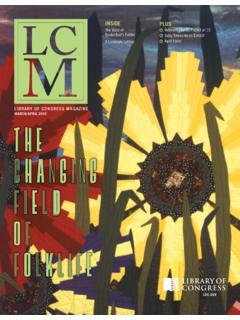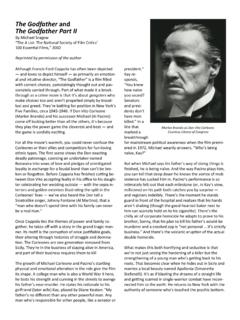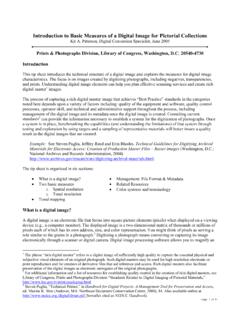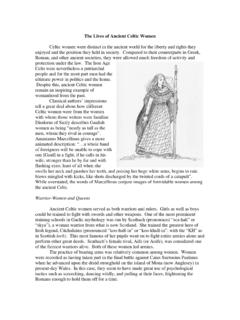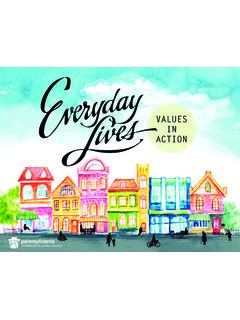Transcription of Children’s Lives at the Turn of the Twentieth Century ...
1 Of African American children s guideprimary source setChildren s Lives at the Turn of the Twentieth Century The dawn of the Twentieth Century was a time of great change in the United States, and many of those changes can be seen in the Lives of the nation s children how they worked, played, learned, and made sense of the BackgroundIn 1900, the was a diverse nation, and its children lived in a wide range of circumstances different geographic settings, economic backgrounds, and family structures. The country was experiencing tremendous growth, and more and more families were living in cities, although a majority of Americans lived in the country until 1920. Many children lived in terrible poverty, while others were part of a growing middle class. At the same time, a great increase in immigration brought children from all over the globe, but especially from southern and eastern Europe, into the American and WorkRural children often worked on their family s farms, helping with the endless tasks that were completed using human and animal power.
2 Many children in cities and towns also worked: in mines, in factories, selling newspapers and food, and shining shoes. Concerns over child labor found support among the Progressives the growing number of people who believed government should take an active role in solving social and economic problems of society. In 1904 the National Child Labor Committee was formed to advocate for children in the work force. In the next few years, the federal government passed several laws to try to regulate child labor, but the Supreme Court declared them unconstitutional. Not until 1938 did the federal government successfully regulate the minimum age of employment and hours of work for turn of the Twentieth Century also saw great changes in the education available to children around the nation. In the late 1800s, public schools were becoming more numerous, and states were beginning to require school attendance.
3 By 1920, all the states required students aged 8 to 14 to attend school for part of the year; in rural areas, the school was somewhat shorter because young people were still needed to work on the farm. Rural areas made the one-room schoolhouse famous in many of these, the grades studied together in a single room, and were taught by one teacher. In urban areas, of course, schools were larger and students worked in separate classrooms according to their grade level. Students today would be surprised at the sparseness of the classrooms 100 years ago there were many fewer books and what we today consider school supplies. Rather than markers, scissors, glue sticks, paper, computers, and more, students in the early Twentieth Century probably had only a slate and chalk. Discipline could be rather strict, and learning was frequently by rote memorization.
4 There was no school lunch program; instead, students carried their lunch to school, often in a metal at the turn of the Twentieth Century loved to play as much as children today do, and many of the favorite games of a hundred years ago are still popular today. However, the places in which children played and the toys they had at their disposal changed greatly. Parks and playgrounds were built in unprecedented numbers around the turn of the Century , partly as a result of the Progressive and conservation movements. New organizations such as the YMCA and the Boy Scouts sprang up, aiming to provide urban youth with exercise and character-building experience. Factory-made toys were uncommon in the nineteenth Century most toys were either home-made or fairly simple. Early in the Twentieth Century , though, as the nation became more industrialized, toys began to be manufactured on a large scale.
5 The first two decades of the Century saw the introduction of many classic toys, including the Lionel Train (1901), Crayola Crayons (1903), and Lincoln Logs (1916). New design improvements in the 1880s and 1890s made bicycles safer, and bikes and tricycles came into children s hands in much greater numbers, providing countless children with the tools to explore the changing world around house in Kirkland, Georgia boy and York City school Pupil in Pleasant Green School, West for TeachersWork with students to look for details in the photos that give insight into life 100 years ago. Ask students to look at a photograph for 30 seconds and memorize any details they see. After students share what they noticed in the photograph, have the students take a second look. What do they notice now that they didn t see before?Select an image and ask students to focus their attention on a particular feature, such as the physical surroundings, the clothes people are wearing, or objects in the picture.
6 Help students identify objects that aren t familiar to selections from the Children s Object Book and pictures of children s homes. Discuss what students notice about the homes of children 100 years ago. Compare and contrast the objects in the book to the common features found in modern homes. What is the same? What has changed? What is missing? (You may conduct a similar analysis using the photographs of classrooms.) Ask students to find an item in the set that shows children doing an activity that children still do today, circle details in the original image that have changed, and explain how they have changed. Help students reflect on their observations by asking: How are the children in the pictures similar to and different from you and your classmates? What do we know about children 100 years ago based on this picture? Students may use their observations about life 100 years ago to draw pictures of how children today might look like doing a similar activity, and compare the pictures.
7 They may also work in groups to write and perform a skit showing this activity 100 years ago. Do their classmates agree with how the activity would have changed?Ask students to choose an activity they do regularly, and encourage them to think about how the activity would have been different 100 years set includes photographs of children at work. Help students think about their own work experiences by asking how many of them do chores at home and how many do work outside of their home, and get paid for it. As a class, discuss why children might have worked 100 years ResourcesDetroit Publishing Company Child Labor Committee Benjamin Johnston Sources with Citations Girls Playground, Harriet Island, St. Paul, Minn. Photograph. Detroit: Detroit Publishing Co., c1905. From Library of Congress, Detroit Publishing Company Just Kids. Photograph. Detroit: Detroit Publishing Co., c1904.
8 From Library of Congress, Detroit Publishing Company through our country - an instructive geographical game for the young. Print. c1890. From Library of Congress: Popular Graphic , , photographer. Annual Baby Parade, 1904, Asbury Park, United States: Thomas A. Edison, Inc., 1904. From Library of Congress, America at Work, America at Leisure: Motion Pictures from Children s Object Book. Book. London and New York: Frederick Warne & Co., 188?. From Library of Congress, Rare Book and Special Collections , Emile, author. Muddy Jim and Other Rhymes: 12 Illustrated Health Jingles for Children. Picture book. Washington, : Jim Publication Company, 1919. From Library of Congress, Emile Berliner and the Birth of the Recording Industry. :@field(NUMBER+@band(berl+04010600))John ston, Frances Benjamin, photographer. Elementary School Children Standing and Watching Teacher Write at Blackboard, Washington, Photograph.
9 Washington, : Frances Benjamin Johnston School Survey, 1899. From Library of Congress, Francis Benjamin Johnston , Frances Benjamin, photographer. [Washington, Public Schools - classroom scenes and school activities]. Photograph. Washington, : Frances Benjamin Johnston School Survey, 1899. From Library of Congress, Francis Benjamin Johnston Collection. Eskimo children and puppies at the Moravian Mission Station. Photograph. Between ca. 1900 and ca. 1930. From Library of Congress, Frank and Frances Carpenter Collection. , Solomon D., photographer. [Sylvester Rawding family in front of sod house, north of Sargent, Custer County, Nebraska]. Photograph. Sargent, NE: 1886. From Library of Congress, Prints and Photographs Division. [Children posed with bicycle and tricycles]. Photograph. Detroit Publishing Co., 1919. From Library of Congress, Detroit Publishing Company Photograph Living on a skyscraper.
10 Photograph. ca. 1919 From Library of Congress: George Grantham Bain & Ewing, photographer. [Group of African American children playing]. Photograph. Between 1915 and 1923. From Library of Congress: Harris & Ewing Koo & Sze children. Photograph. [between 1918 and 1920]. From Library of Congress: National Photo Company , Lewis W., photographer. [Series showing the day s work of Estelle and Felix Humphrey. See card reports of same. Hine] Location:[Elizahbethtown vicinity, Kentucky]. Photograph. May 1916. From Library of Congress, National Child Labor Committee , Lewis Wickes, photographer. High up on the top floor of a rickety Photograph. New York, NY: 1912. From Library of Congress, National Child Labor Committee , Lewis Wickes, photographer. Rhodes Mfg. Co., Lincolnton, Spinner. A moments glimpse of the outer world Said she was 10 years old. Been working over a year.
